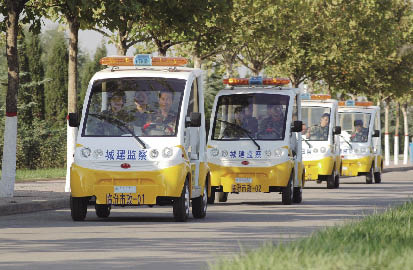|
Zhang Guisheng, 54, is a garbage collector. Dressed for work in a cheap gray jacket, work shirt and dark gray woolen vest, his battered shoes are covered in fine, grey dust. "Water from the Qingzhang River was clean enough to drink until chemical factory and power plant pollution poisoned it," Zhang says.
Zhang's observation is backed up by the findings of the Shanxi Provincial Bureau of Environmental Protection test report of 2007: "Surface water in Shanxi Province is heavily polluted. Of the 103 sections monitored, 64 were heavily polluted. Pollution has seriously degenerated water ecology."
People in the county town speak of the thick smoke that billows from tall chimneys in small factories. Residents of Wulihou Village, Liaoyang Town, Zuoquan County, complain about the bad air caused by ore dressing and thermal power plant emissions, and people living near the chemical plant about pungent odors that irritate their nasal passages.
The sulphur dioxide content in the atmosphere of Shanxi's 11 major cities in 2007 exceeded Chinese government standards. The Shanxi Provincial Bureau of Environmental Protection test report states, "Air pollution in major cities in the province comprises sulphur dioxide and coal dust."
Almost 80 percent of Shanxi's 119 counties (county-level cities) have mineral resources. Growth of high-polluting enterprises such as coal washing, coking and iron smelting has made the cultivation of pollution-free agriculture impossible on 15 percent of arable land in the province. Painted on the wall of a small stone-crushing plant on a rutted country road was the slogan, surrounded with advertisements for motorcycles and chemical fertilizer, warning, "If you don't protect your environment, your beautiful scenery will vanish."
As it was late autumn, local farmers were burning stalks in the fields.
Burning crop stalks in the fields is a problem in rural areas. "In the past, stalks were used as livestock fodder and cooking fuel. Tractors have replaced draught animals, and now coal and natural gas are our main sources of fuel," Zhang Guisheng explains. And as county cadres responsible for forest protection say, "Going from village to village prohibiting the burning of stalks is hard work, and not always effective, because people are more concerned about making quick cash than preventing air pollution."
Countermeasures
 |
|
Environment-monitoring cars patrol Linfen, Shanxi Pronvince. Uncredited photos by China Foto Press |
"Coordinating sustained economic growth and environmental protection is often difficult," said Bie Tao, deputy director of the Department of Policy and Regulations of the Ministry of Environmental Protection. "China acknowledges that in the 21st century economic growth and environmental protection carry equal priority," says Zhou Shengxian, minister of Environmental Protection. "In the coming three years, China will raise RMB 1 trillion for environmental protection."
| 